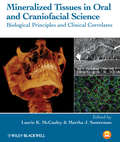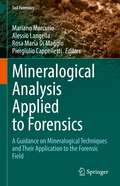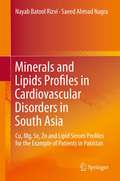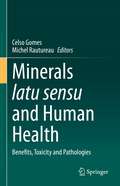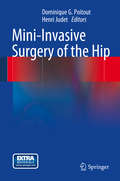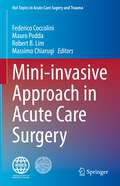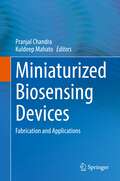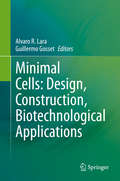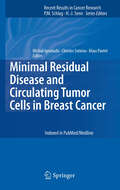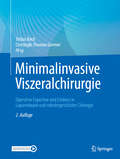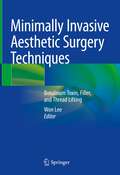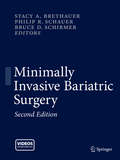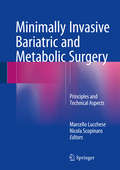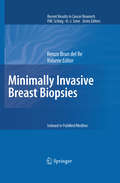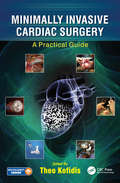- Table View
- List View
Mineralized Tissues in Oral and Craniofacial Science
by Laurie K. Mccauley Martha J. SomermanMineralized Tissues in Oral and Craniofacial Science is a major comprehensive update on knowledge in the field of mineralized tissues in the oral and craniofacial region. Drs. McCauley and Somerman assembled an international team of researchers and clinicians, offering a global perspective on the current knowledge in this field. Basic and clinical correlates reinforce the significance of research to clinical diagnoses and therapies, written in a manner that lends easily to their use for case study teaching venues.Section 1 features the many aspects of bone in the craniofacial region, including embryology, cell biology, and stem cell biology. Section 2 focuses on teeth-tooth development, dentin, enamel, cementum, and tooth regeneration. Section 3 discusses the interaction between bones and teeth, including those associated with inflammatory processes, periodontal ligaments, biomechanics, and other impact factors-such as nutrition, metabolic bone diseases and therapeutic modalities.The novel approach of linking the basic principles of the cell and molecular biology of hard tissues to clinical correlates will appeal to readers at all levels of their research careers, both students and faculty; faculty interested in a comprehensive text for reference; and clinicians interested in the biologic aspects of bones and teeth.
Mineralogical Analysis Applied to Forensics: A Guidance on Mineralogical Techniques and Their Application to the Forensic Field (Soil Forensics)
by Rosa Maria Di Maggio Mariano Mercurio Alessio Langella Piergiulio CappellettiThis book illustrates the main modern mineralogical analytical procedures that can be applied for forensic purposes on various typologies of materials and substances and has both theoretical and practical approach. Moreover, it focuses on all those challenges that can arise with forensic analysis, such as the choice of the most proper mineralogical techniques as a function of the material and its quantity, destructive and non-destructive analyses, sampling procedures, mineralogical analysis of micro-traces, correct preparation of the samples, correct calibration and analytical conditions of the laboratory instrumentation. Numerous case studies on criminal offenses against persons, environment and cultural heritage are illustrated.
Minerals and Lipids Profiles in Cardiovascular Disorders in South Asia
by Nayab Batool Rizvi Saeed Ahmad NagraThis book correlates different minerals and lipids serum profiles with the prevalence of cardiovascular disorders in South Asian countries with special emphasis on Pakistan. Cardiovascular disorders (CVD, e. g. coronary heart diseases, hypertension, rheumatic heart disease, angina, heart failure and deep vein thrombosis) show significantly increasing rates in South Asian countries like Pakistan and have become a major health problem. Nevertheless, the data on any aspect of cardiovascular problems still is scanty. The serum profiles of different minerals (copper, magnesium, zinc, selenium) and lipids are analyzed in detail. The presented data will thus lead to a better understanding of the problem and help to provide possible solutions, which can be achieved, e. g. through ameliorated minerals profiles in the daily diet. These results can help develop better dietary management strategies in the prevention and treatment of CVD.
Minerals latu sensu and Human Health: Benefits, Toxicity and Pathologies
by Michel Rautureau Celso GomesThis volume provides a comprehensive academic review of both positive and negative effects of minerals on human health and quality of life. The book adopts the concept of mineral latu sensu (mineral l.s.), which encompasses a broad spectrum of natural, inorganic, solid, and crystalline, of natural and inorganic chemical elements (metals and metalloids), of modified natural minerals, of biominerals, and of syntetic minerals, all products that branch across the disciplines of earth, soil, environmental, materials, nutrition, and health sciences. Using this broad framework, the authors are able to provide a multidisciplinary assessment on many types of minerals which can be essential, beneficial and hazardous to human health, covering applications in medical geology, medical hydrology or balneotherapy, pharmacology, chemistry, nutrition, and biophysics. The book performs historical analyses of the uses of minerals for therapeutic and cosmetic purposes to better understand current trends and developments in mineral research and human health. The book will be of interest to students, public health officials, environmental agencies and researchers from various disciplines, as well as scientific societies and organizations focusing on medical geology, health resort medicine (crenotherapy, hydrotherapy and climatotherapy), and on pharmaceutical, cosmetic and biomedical applications.
Mini-Invasive Surgery of the Hip
by Dominique G. Poitout Henri JudetIn recent years, mini-invasive surgery has become increasingly important for reducing the risk of infection and minimizing blood loss and volume of implants. Hip surgery requires small incisions, which make the use of the appropriate equipment and an extensive knowledge of the anatomy of the region essential. Mini-invasive surgery requires the surgeon to consider the indications for surgery for each patient he treats and to know the exact loco-regional anatomy for that patient. Methods must be very precise and warrant visual explanations to help teach young surgeons. In this book, the different surgical approaches to the hip are presented in terms of their anatomical specifications and indications. Films of these operations, performed by international specialist authors, and some of these images are used to explain the surgical techniques described in the book. The highly didactic and visual presentation based on filmed operations is very helpful for the understanding of these methods.
Mini-invasive Approach in Acute Care Surgery (Hot Topics in Acute Care Surgery and Trauma)
by Federico Coccolini Mauro Podda Robert B. Lim Massimo ChiarugiThe minimally invasive approach in emergency and general trauma surgery is a key aspect of both scenarios. This book, the first comprehensive manual in the field, takes a global view of the subject and deals with it in depth, ranging from the historical perspective to the pathophysiological and therapeutic aspects in the various body compartments.Thanks to its user-friendly approach, this book will be a useful tool in the daily clinical practice of surgeons, doctors, anesthetists and nurses; thanks to its up-to-date review of the literature, it will remain relevant for several years. Finally, the participation of world opinion leaders in the field guarantees the comprehensive and scientific soundness of the work.
Miniaturized Biosensing Devices: Fabrication and Applications
by Pranjal Chandra Kuldeep MahatoThis book presents tools and techniques for the development of miniature biosensors and their applications. The initial chapters discuss the advancements in the development of the transduction techniques, including optical, electrochemical, and piezoelectric, which are used for miniaturized biosensors. The book also reviews several technologies, such as nanotechnology, nanobiotechnology, immune-technology, DNA-technology, micro-manufacturing technology, electronic-circuit technology to increase the miniaturization and sensitivity of the biosensor platform. Subsequently, the chapters illustrate the applications of miniaturized biosensing systems in point-of-care monitoring of treatment and disease progression, environmental monitoring, food control, drug discovery, forensics, and biomedical research. Towards the end, the book discusses the advanced applications of biosensors in water quality monitoring, especially on-line detection systems and on-site detection of pesticides, heavy metals and bacteria in water. This book is an invaluable source for scientists working in biochemical engineering, bioengineering, and biomedical engineering in academia and industry.
Minidictionary for Nurses (5th edition)
by Elizabeth A. Martin Tanya A. McferranThe fifth edition of this best-selling and trusted dictionary has been fully updated and revised to take account of recent developments in nursing practice and related fields. Updates cover the fields of surgical techniques, paediatrics, gynaecology, nephrology, endocrinology, and ENT, as well as the latest reorganization of the National Health Service. Fully revised, this dictionary provides comprehensive coverage of the ever-expanding vocabulary of the nursing professions. In addition to specifically nursing terms, there are many entries in the fields of medicine, anatomy, physiology, psychiatry, nutrition, and pharmacology (including new drugs recently introduced into medical practice). Over 10,100 clear and concise entries, all written by medical and nursing specialists, cover the theory and practice of nursing. 100 helpful illustrations and 12 appendices covering nutritional requirements, normal values for biochemical and haematological data, standard values for body weight, and much more, make this an invaluable reference tool for all nursing students and professionals.
Minimal Cells: Design, Construction, Biotechnological Applications
by Guillermo Gosset Alvaro R. LaraThis book provides a comprehensive overview of the design, generation and characterization of minimal cell systems. Written by leading experts, it presents an in-depth analysis of the current issues and challenges in the field, including recent advances in the generation and characterization of reduced-genome strains generated from model organisms with relevance in biotechnology, and basic research such as Escherichia coli, Corynebacterium glutamicum and yeast. It also discusses methodologies, such as bottom-up and top-down genome minimization strategies, as well as novel analytical and experimental approaches to characterize and generate minimal cells. Lastly, it presents the latest research related to minimal cells of serveral microorganisms, e.g. Bacillus subtilis.The design of biological systems for biotechnological purposes employs strategies aimed at optimizing specific tasks. This approach is based on enhancing certain biological functions while reducing other capacities that are not required or that could be detrimental to the desired objective. A highly optimized cell factory would be expected to have only the capacity for reproduction and for performing the expected task. Such a hypothetical organism would be considered a minimal cell. At present, numerous research groups in academia and industry are exploring the theoretical and practical implications of constructing and using minimal cells and are providing valuable fundamental insights into the characteristics of minimal genomes, leading to an understanding of the essential gene set. In addition, research in this field is providing valuable information on the physiology of minimal cells and their utilization as a biological chassis to which useful biotechnological functions can be added.
Minimal Residual Disease Testing: Current Innovations and Future Directions
by Todd E. DruleyThis volume provides a concise yet comprehensive overview of minimal residual disease (MRD) testing. The text reviews the history of MRD testing, MRD testing for acute lymphoblastic leukemia/lymphoma, molecular diagnostics for MRD analysis in hematopoietic malignancies, the use of "difference from normal" flow cytometry in monitoring AML response, ML-DS for measurable residual disease detection, and advancements in next generation sequencing for detecting MRD. Written by experts in the field, Minimal Residual Disease Testing: Current Innovations and Future Directions is a valuable resource for hematologists, oncologists, pathologists, and radiologists on the variety of technologies available to detect MRD and how best to integrate these platforms into clinical practice.
Minimal Residual Disease and Circulating Tumor Cells in Breast Cancer
by Christos Sotiriou Michail Ignatiadis Klaus PantelThis important book provides up-to-date information on a series of topical issues relating to the approach to minimal residual disease in breast cancer patients. It first explains how the study of minimal residual disease and circulating and disseminated tumor cells (CTCs/DTCs) can assist in the understanding of breast cancer metastasis. A series of chapters then discuss the various technologies available for the detection and characterization of CTCs and DTCs, pinpointing their merits and limitations. Detailed consideration is given to the relevance of CTCs and DTCs, and their detection, to clinical research and practice. The role of other blood-based biomarkers is also addressed, and the closing chapters debate the challenges facing drug and biomarker co-development and the use of CTCs for companion diagnostic development. This book will be of interest and assistance to all who are engaged in the modern management of breast cancer.
Minimalinvasive Viszeralchirurgie: Operative Expertise und Evidenz in Laparoskopie und robotergestützter Chirurgie
by Christoph-Thomas Germer Tobias KeckAuch die 2. Auflage stellt das Expertenwissen zu etablierten und innovativen laparoskopischen und retroperitoneoskopischen Operationen systematisch und detailliert dar. Neu hinzugekommen sind Kapitel zum Einsatz der Robotik in der MIC. Alle Kapitel wurden für die Neuauflage aktualisiert, zahlreiche Abbildungen ausgetauscht, die Texte neu gestaltet und übersichtlicher strukturiert. Zum Buch gehören zahlreiche Videos zu Operationsverläufen, die direkt mit der Springer MoreMedia-App aufgerufen werden können.
Minimalinvasive nichtoperative Methoden in der Gesichtsästhetik: Vom Filler zum Fadenlift
by Hans-Robert Metelmann Wolfgang FunkDieses Buch beschreibt die Anwendungsmöglichkeiten von minimalinvasiven Maßnahmen ohne Skalpell und Endoskop als Alternative und Ergänzung zur ästhetischen Gesichtschirurgie. Es wird detailliert auf die anatomischen und histologischen Besonderheiten der ästhetischen Zonen des Gesichts und der beteiligten Gewebearten eingegangen. Das dargestellte Methodenspektrum erstreckt sich von ablativen Maßnahmen, etwa das chemische und mechanische Peeling sowie Laserbehandlungen, über Füllmaterialien zur Volumenaddition, wie zum Beispiel Hyaluronsäure, Calcium-Hydroxylapatit oder Eigenfett, bis zu Gewebsverlagerung über Fadenkonstruktionen mit Häkchensystemen und Systemen mit „cones“. Als moderner Ansatz unter den minimalinvasiven Maßnahmen wird die Regeneration des Gewebes durch Stammzellen und Wachstumshormone dargestellt, wobei die Regeneration des Gewebes durch die Behandlung mit thrombozytenreichem Plasma (PRP), durch Needling-Verfahren oder Eigenfett aktiviert wird. Behandlungen mit Botulinumtoxin A zur Muskelrelaxation und zur Schweißdrüsenbehandlung, Kryolipolyse, die Fett-weg-Spritze und die transkutane Lipektomie erweitern die minimalinvasiven Möglichkeiten in der Gesichtsästehtik.Für Ärzte, die sich auf dem Gebiet der Minimalinvasiven, Plastischen und Ästhetischen Maßnahmen weiter bilden möchten. Ergänzend zum gedruckten Werk finden Sie per App zahlreiche Videos, die die Verfahren in der Praxis zeigen.
Minimally Invasive (MI) Orthognathic Surgery: A Systematic Step-by-Step Approach
by Gwen R. J. SwennenThis comprehensive and visually engaging color atlas and manual serves as an invaluable resource for orthognathic and orthofacial surgeons seeking detailed information on the various aspects of minimally invasive (MI) orthognathic surgery. The initial two chapters lay the foundation for a groundbreaking and innovative approach to MI orthognathic surgery, drawing from a wealth of 25 years of experience. The authors delve into the rationale behind this novel concept, aiming to enhance surgical efficiency and minimize patient morbidity. They present an in-depth exploration of the new surgical algorithm, which encompasses a systematic, step-by-step standardization of MI orthognathic techniques. The development of specialized MI orthognathic instruments and the introduction of innovative surgical codes, sequences, and templates are thoroughly elucidated. Subsequently, the following five chapters meticulously outline the "step-by-step" MI surgical techniques for the five primary orthognathic surgical procedures. These descriptions are accompanied by detailed illustrations, ensuring a comprehensive understanding of each technique. In the closing chapter, the book delves into the essential conditions required for successful MI orthognathic surgery, providing a thorough exploration of these necessary prerequisites. This book serves as a practical and user-friendly guide, offering clear and straightforward "step-by-step" instructions suitable for residents in training, junior surgeons, as well as experienced practitioners. Orthognathic and orthofacial surgeons will find "Minimally Invasive (MI) Orthognathic Surgery" to be an outstanding companion in their routine surgical practice.
Minimally Invasive Acute Care Surgery
by Jose J. Diaz Kosar A. KhwajaThis text is designed to present a comprehensive, up to date and safe approach to managing emergency general surgery patients with a minimally invasive approach. This book bridges the gap between the minimally invasive surgery (MIS) expert who may not routinely be involved in the care of the acute care surgery patient and the ACS expert surgeon who may not have a routine MIS elective practice. The first section reviews the physiology of the acute care surgery patient and the physiologic impact of MIS techniques including pnemoperitoneum in critically ill patients. This review is crucial to assure that the surgeon has a clear understanding of when a MIS approach is safe and when it can be potentially dangerous to the patient. The illustrations are presented in an atlas-style format to describe the surgical procedures. The authors of the various sections are minimally invasive and acute care surgeons from prominent academic centers. The format represents a narrative review with appropriate illustrations and links to online videos.
Minimally Invasive Aesthetic Procedures: A Guide for Dermatologists and Plastic Surgeons
by Adilson Da CostaMinimally invasive aesthetic procedures are an important part of dermatologists’ day-to-day clinical routine. However, plastic surgeons are also becoming more willing to explore them, and minimally invasive cosmetic and aesthetic procedures are now an established interdisciplinary topic. Minimally Invasive Aesthetic Procedures - A Guide for Dermatologists and Plastic Surgeons addresses the needs of both these specialties. It provides a comprehensive overview of the most relevant and widely used minimally invasive procedures, presented in a practical and straightforward style. Rather than a broad overview of the literature, it offers a step-by-step guide to clinical procedures. Each chapter explores a single clinical procedure, discussing the theoretical basis; the materials needed; the methods and techniques; clinical follow-up; before-and-after illustrations; as well as the side effects and complications and their management. It also includes a summary of tips and relevant references.With more than a hundred procedures presented and discussed in a clinically applicable format, Minimally Invasive Aesthetic Procedures - A Guide for Dermatologists and Plastic Surgeons is a practical manual for all dermatology and plastic surgery practitioners who are interested in aesthetic medicine.
Minimally Invasive Aesthetic Surgery Techniques: Botulinum Toxin, Filler, and Thread Lifting
by Won LeeIn this book, authors will describe various techniques about botulinum toxin injection, filler injection and thread lifting based on latest evidences of minimally invasive plastic surgery techniques. For example, doppler ultrasound guided filler injection technique, short scar minimally invasive thread lifting techniques, and neck lifting techniques. Also described the basic knowledge for minimally invasive aesthetic techniques such as hyaluronic acid filler properties and rheology, threads components and classifications, and botulinum toxin classifications. Simple and easy techniques are described for beginners and also showed step by step injecting photographs. Also described basic anatomy for botulinum toxin, filler injection and thread lifting. Various detail illustrations and clinical photographs will be presented to help readers easier understanding and performing procedures.
Minimally Invasive Approaches in Endodontic Practice
by Gianluca PlotinoThis book describes the latest minimally invasive approaches in endodontics and explains the principles that guide them. The advantages and limitations of these approaches are critically analyzed with the intention of defining new endodontic gold standards. The trend toward the use of more conservative procedures within endodontics reflects the wider adoption of minimally invasive dentistry in general and is being fostered by the introduction of new materials, devices, instruments, and techniques as well as the use of magnification and advanced three-dimensional diagnostic imaging technologies. In this book, readers will find clear explanation of these advances and their impacts. Minimally invasive access to the root canal system is described, and detailed attention is devoted to the application of novel strategies in root canal instrumentation and disinfection, root canal filling, coronal restoration, retreatment, and endodontic surgery. Minimally invasive alternatives to complete endodontic treatment, such as vital pulp therapies, and to dental extraction and implant placement, including surgical extrusion, intentional replantation, and tooth autotransplantation, are also discussed. Minimally Invasive Approaches in Endodontic Practice will be of value for endodontists at all levels of experience.
Minimally Invasive Approaches to Colon and Rectal Disease
by FACS David E. Rivadeneira Scott R. Steele Howard M. Ross MD FACS FASCRS Sang W. Lee Fascrs Matthew G. MutchThis text provides a clear, reproducible, step-by-step guide for each colorectal surgery operation. The format follows that of both a "how to" manual as well as an algorithm-based guide to allow the reader to understand the thought process behind the proposed treatment strategy. Each chapter includes both operative technical details as well as perioperative "tips and tricks" that the authors utilize in the management of these complex surgical patients. In addition, it addresses the optimal "next step" in dealing with more challenging situations such as pregnancy, emergent surgery, the elderly, and the obese patient. Throughout the text, each author provides an ongoing narrative of his/her individual surgical techniques along with color illustrations and diagrams to "personally" take the reader through the crucial steps of the procedure, as well as key points of patient care inherent to that topic. Additionally, where appropriate, links to online or downloadable videos will give the reader an up-front look into technical aspects of traditional straight laparoscopic and hand-assisted minimally invasive surgery, as well as NOTES, transanal, robotic, single incision colectomy and combined laparoscopic-endoscopic resection. Minimally Invasive Approaches to Colon and Rectal Disease: Technique and Best Practices will be of great utility to colorectal, general and oncologic surgeons who want to learn or improve their minimally invasive skills in colorectal surgery. Furthermore, this text will be of particular interest to the surgeons-in-training, and the general and colorectal surgeon who is often called upon to manage a variety of colorectal surgery conditions through a minimally invasive approach.
Minimally Invasive Bariatric Surgery
by Stacy A. Brethauer Philip R. Schauer Bruce D. SchirmerThe second edition of Minimally Invasive Bariatric Surgery provides a comprehensive, state-of-the art review of this field, and it serves as a valuable resource for clinicians, surgeons and researchers with an interest in minimally invasive bariatric surgery. Additionally, the second edition includes new features that will benefit the resident, fellow, or bariatric surgeon new to the field. Specifically, each evidence-based chapter (i. e. outcomes, complications, epidemiology, etc) concludes with three or four exam questions that emphasize the salient points of the chapter and provide fellowship programs a valuable training tool and resource for their academic curriculum. These questions are either single-answer multiple choice or true/false format and the correct response with a brief explanation follows. As more emphasis is placed on completing a comprehensive curriculum and obtaining certification for bariatric training, this aspect of the book is unique and provides added value to the text. The new edition also incorporates many new or updated medical illustrations to enhance the technique chapters and provide more uniformity for the artwork throughout the book. Each of the major procedures include surgical technique, outcomes, and management of complications in separate chapters to provide an easy reference for the busy clinician preparing for a case or presentation. Another unique feature of the text is a link to video files hosted online for the relevant chapters. This video library will be of great value to the user. As the number of fellowships in laparoscopic bariatric surgery continues to increase, this updated text will provide a valuable resource for general and bariatric surgeons, laparoscopic surgeons, fellows, residents, medical students, obesity researchers, and industry representatives involved in this field.
Minimally Invasive Bariatric and Metabolic Surgery
by Marcello Lucchese Nicola ScopinaroThis book explains the concept of metabolic surgery and provides step-by-step descriptions of all the principal minimally invasive surgical techniques employed to treat morbid obesity. The approach adopted is very practical. For each procedure, indications, technical aspects, clinical management and outcomes are described and helpful tips and tricks, highlighted. Guidance is provided on the management of emergencies and potential complications, as well as on general postoperative management and long-term follow-up. The coverage also includes new frontiers of robotic and endoscopic surgery. While the focus is on surgical techniques, emphasis is placed on the need for a multidisciplinary approach, with explanation of the role of the multidisciplinary team and the bariatric center. In addition, important information is presented on the definition of morbid and severe obesity, incidence/prevalence, pathophysiology and obesity-related comorbidities. The authors are internationally acknowledged experts who present best practice know-how in the field and draw on the most recent research literature.
Minimally Invasive Breast Biopsies
by Renzo Brun del ReModern imaging methods have made it possible to detect breast cancer at an earlier stage than in the past. Nevertheless, a large majority of suspicious findings at screening subsequently prove to be benign. It is therefore important to be able to identify benign lesions in a manner that is reliable, tissue sparing, patient friendly, and cost-effective. More than 70% of breast biopsies can now be performed using minimally invasive procedures that meet these criteria. This book examines in detail vacuum-assisted minimally invasive breast biopsy systems (ATEC, EnCor, Intact, Mammotome and Vacora), stereotactic systems, MRI-guided procedures, and ductoscopy. Further chapters are devoted to the pathology of the breast tissue obtained using these procedures, their limitations, the implications of recent advances in breast imaging, and the results of cost-benefit analyses. The closing chapter provides a systematic review and meta-analysis of recent data.
Minimally Invasive Cancer Management
by Frederick L. Greene B. Todd HenifordAs minimal access approaches to cancer diagnosis, staging, and therapy become more widely used, it is vital for general surgeons, along with laparoscopists, surgical oncologists and medical oncologists, to stay up to date. The editors, a team consisting of a renowned surgical oncologist and a laparoscopic specialist, aim to provide a resource for the practicing general surgeon using basic minimally invasive techniques. The book discusses diagnosis including biopsy with microinstrumentation, staging, and palliative and curative resection. Specific tumor sites are addressed, including esophagus, stomach, spleen, small bowel, pancreato-biliary, hepatic resection, and colo-rectal resection. Minimally invasive approaches to the thoracic and retroperitoneal areas are included. The book provides a thorough overview of basic cancer biology, instrumentation, and ultrasound. Additionally, Greene and Heniford explore controversial issues such as port-site recurrence and the effect of pneumoperitoneum on the spread of cancer cells in the abdomen. Many photographs and line drawings, including 16 in full color, illustrate the principles discussed in the text. A must-have for every practicing general surgeon, laparoscopic fellow, and general surgery resident.
Minimally Invasive Cardiac Surgery: A Practical Guide
by Theo KofidisMinimally invasive cardiac surgery(MICS) is an integral component of every future cardiac surgeon’s training. There continues to be a growing global demand towards less invasive surgical techniques. Both cardiologist and cardiac surgeon form "heart teams" to provide patients with novel, minimally invasive procedures, with all their benefits. Less invasive techniques are often complex and require special knowhow and skills. This book offers an innovative approach to learning, utilizing QR code technology, which refers the reader to essential audio-visual material, which, along with the didactic text, focuses on practical aspects of minimally invasive cardiac surgery. In modern Heart Teams, and with the advent of the hybrid era, surgeons will only be able to survive if they have state-of-the-art skills in less invasive technologies, which can be incorporated in the hybrid theatre and/or trans-catheter arena. This text accompanies the surgeon along this path, and provides clinical advice and practical solutions, beyond the necessary basic knowledge. Which courses to visit, which videos to watch, which centres to join for serious training? How best to exploit public and multimedia? How to consent a patient into a MICS procedure? How to set up a MICS program or practice? In the era of value driven outcomes, and a shift towards shorter and better patient journeys, MICS is a skill that no heart surgeon can be without. Minimally Invasive Cardiac Surgery: A Practical Guide is a teaching resource, reference book and manual written by surgeons who both operate and teach the procedures described within. Provides access to online resources via QR codes Includes links to videos and the e-version of the text Acts as a gateway to a huge choice of minimally invasive cardiac surgery materials
Minimally Invasive Coloproctology
by William C. S. Meng Hester Y. S. Cheung David T. Y. Lam Simon S. M. NgIn this book, pioneers and distinguished masters of surgery describe novel minimally invasive colo- and anorectal procedures that have been developed in Asia but are of international applicability. The presented techniques are wide ranging in nature and relate to colon surgery, rectal surgery and the treatment of hemorrhoids, fistulas and chronic constipation. Each procedure is carefully described with the aid of high-quality color photographs and illustrations, drawing attention to many practical tips and tricks. In addition to the techniques themselves, state of the art technology is introduced that is now being applied clinically in China, Hong Kong, Asia-Pacific, and beyond. The book will enable readers both to grasp the concepts underlying these important new approaches and advances and to reproduce the techniques in their own surgical practice.
